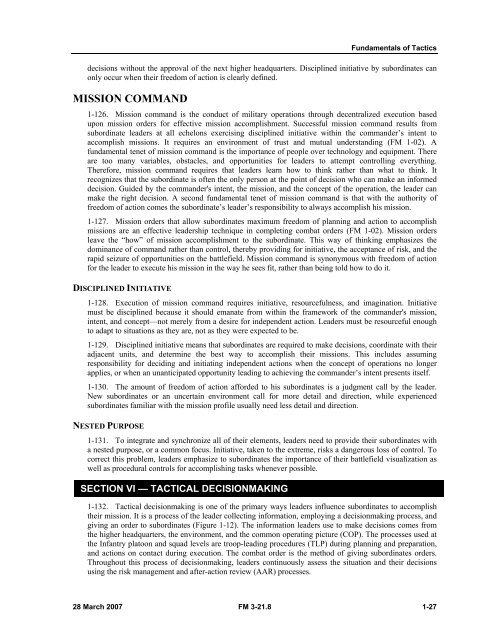Infantry Rifle Platoon and Squad - Sakai
Infantry Rifle Platoon and Squad - Sakai
Infantry Rifle Platoon and Squad - Sakai
Create successful ePaper yourself
Turn your PDF publications into a flip-book with our unique Google optimized e-Paper software.
Fundamentals of Tactics<br />
decisions without the approval of the next higher headquarters. Disciplined initiative by subordinates can<br />
only occur when their freedom of action is clearly defined.<br />
MISSION COMMAND<br />
1-126. Mission comm<strong>and</strong> is the conduct of military operations through decentralized execution based<br />
upon mission orders for effective mission accomplishment. Successful mission comm<strong>and</strong> results from<br />
subordinate leaders at all echelons exercising disciplined initiative within the comm<strong>and</strong>er’s intent to<br />
accomplish missions. It requires an environment of trust <strong>and</strong> mutual underst<strong>and</strong>ing (FM 1-02). A<br />
fundamental tenet of mission comm<strong>and</strong> is the importance of people over technology <strong>and</strong> equipment. There<br />
are too many variables, obstacles, <strong>and</strong> opportunities for leaders to attempt controlling everything.<br />
Therefore, mission comm<strong>and</strong> requires that leaders learn how to think rather than what to think. It<br />
recognizes that the subordinate is often the only person at the point of decision who can make an informed<br />
decision. Guided by the comm<strong>and</strong>er's intent, the mission, <strong>and</strong> the concept of the operation, the leader can<br />
make the right decision. A second fundamental tenet of mission comm<strong>and</strong> is that with the authority of<br />
freedom of action comes the subordinate’s leader’s responsibility to always accomplish his mission.<br />
1-127. Mission orders that allow subordinates maximum freedom of planning <strong>and</strong> action to accomplish<br />
missions are an effective leadership technique in completing combat orders (FM 1-02). Mission orders<br />
leave the “how” of mission accomplishment to the subordinate. This way of thinking emphasizes the<br />
dominance of comm<strong>and</strong> rather than control, thereby providing for initiative, the acceptance of risk, <strong>and</strong> the<br />
rapid seizure of opportunities on the battlefield. Mission comm<strong>and</strong> is synonymous with freedom of action<br />
for the leader to execute his mission in the way he sees fit, rather than being told how to do it.<br />
DISCIPLINED INITIATIVE<br />
1-128. Execution of mission comm<strong>and</strong> requires initiative, resourcefulness, <strong>and</strong> imagination. Initiative<br />
must be disciplined because it should emanate from within the framework of the comm<strong>and</strong>er's mission,<br />
intent, <strong>and</strong> concept—not merely from a desire for independent action. Leaders must be resourceful enough<br />
to adapt to situations as they are, not as they were expected to be.<br />
1-129. Disciplined initiative means that subordinates are required to make decisions, coordinate with their<br />
adjacent units, <strong>and</strong> determine the best way to accomplish their missions. This includes assuming<br />
responsibility for deciding <strong>and</strong> initiating independent actions when the concept of operations no longer<br />
applies, or when an unanticipated opportunity leading to achieving the comm<strong>and</strong>er’s intent presents itself.<br />
1-130. The amount of freedom of action afforded to his subordinates is a judgment call by the leader.<br />
New subordinates or an uncertain environment call for more detail <strong>and</strong> direction, while experienced<br />
subordinates familiar with the mission profile usually need less detail <strong>and</strong> direction.<br />
NESTED PURPOSE<br />
1-131. To integrate <strong>and</strong> synchronize all of their elements, leaders need to provide their subordinates with<br />
a nested purpose, or a common focus. Initiative, taken to the extreme, risks a dangerous loss of control. To<br />
correct this problem, leaders emphasize to subordinates the importance of their battlefield visualization as<br />
well as procedural controls for accomplishing tasks whenever possible.<br />
SECTION VI — TACTICAL DECISIONMAKING<br />
1-132. Tactical decisionmaking is one of the primary ways leaders influence subordinates to accomplish<br />
their mission. It is a process of the leader collecting information, employing a decisionmaking process, <strong>and</strong><br />
giving an order to subordinates (Figure 1-12). The information leaders use to make decisions comes from<br />
the higher headquarters, the environment, <strong>and</strong> the common operating picture (COP). The processes used at<br />
the <strong>Infantry</strong> platoon <strong>and</strong> squad levels are troop-leading procedures (TLP) during planning <strong>and</strong> preparation,<br />
<strong>and</strong> actions on contact during execution. The combat order is the method of giving subordinates orders.<br />
Throughout this process of decisionmaking, leaders continuously assess the situation <strong>and</strong> their decisions<br />
using the risk management <strong>and</strong> after-action review (AAR) processes.<br />
28 March 2007 FM 3-21.8 1-27

















